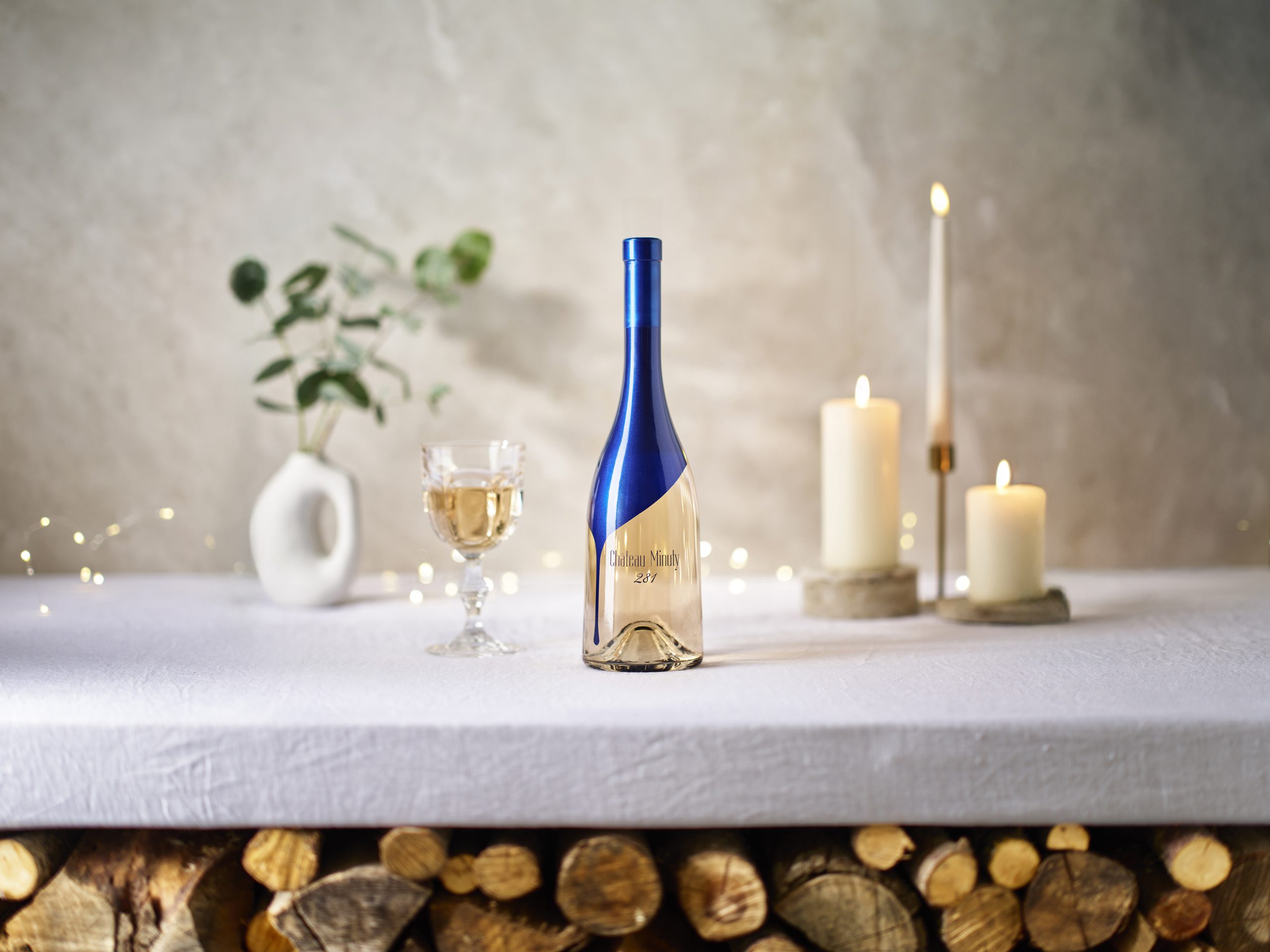Grand Cru rosé: the verdict
Bordeaux does not make a great deal of rosé and what it does is rarely categorised as Grand Cru – however our Bordeaux correspondent Colin Hay finds that Grand Cru rosé not only exists across France, but is also not universally staggeringly expensive. Here is his run down of the best Grand Cru rosés.
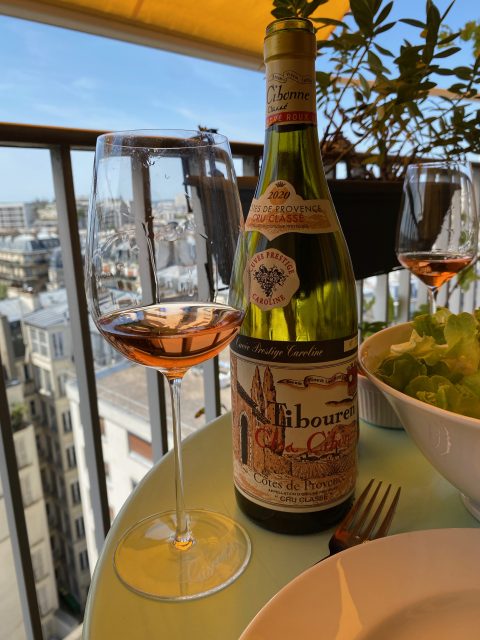
The prices listed below are from Wine Searcher and are the cheapest price listed in Europe, presented per bottle in bond in sterling-equivalent terms. However, a word of caution is required. Since many of these wines are intended for the restaurant sector, they are often difficult to source at their cheapest available price.
- Amistà 2021 (Côtes de Provence, Cru Classé; 60% Grenache Noir, 20% Cinsault, 10% Syrah, 5% Mourvèdre and 5% Tibouren; only around 5000 bottles produced from this fascinating project between Chateau Roubine and Edmond de Rothschild Heritage; certified organic and biodynamic; 13% alcohol). A very pretty light salmon pink, shading towards orange. Big and rich, but subtly so. On the nose this is delicate yet expressive, slightly sweet, with a captivating tomato consommé note alongside the wild strawberry, ripe peach flesh, rosewater and citrus elements (pink grapefruit in prominent position). On the palate, there’s an impressive dynamism and forward momentum which you pick up before you notice the breadth and richness which is, in turn, supported by a lovely saline minerality. Long and quite graceful with a hint of blackcurrant leaf on the finish. This is classy but also very much in the Côtes de Provence style that the consumer is looking for – the vinosity is there but its subtly disguised in something quite crowd-pleasing. 93. (c. £17 in bond per bottle)
- Domaine de la Bégude 2020 (Bandol; 80% Mourvèdre; 15% Grenache; 5% Cinsault; a final yield of 24 hl/ha; from 20 hectare on an argilo-calcaire terroir; certified organic since 2006; 12.5% alcohol). Shocking ruby pink (more clairet than rosé) and bright and radically different on the nose – immediately engaging with pomegranate, red cherry, pear skin and strawberry notes, almost a hint of smoked charcuterie, a touch of chive and the sensation of hot sunshine on a dusty baked clay path. This is quite radical in a way. There’s much more extraction (as the colour shows) and that means one detects the crumbly argilo-calcaire tannins from the mid-palate all the way to the long finish – I really like that. The terroir also brings salinity and a complex minerality that makes this, for me, one of the more interesting wines on display. Though it’s highly coloured and the tannins are palpably present on the finish, tasted blind we could almost be drinking a white from the Southern Rhone. It’s a little more slender than L’Irréductible (as you might imagine) but excellent value for the more adventurous rosé aficionado. 91. (c. £16 in bond per bottle)
- Domaine de la Bégude L’Irréductible 2020
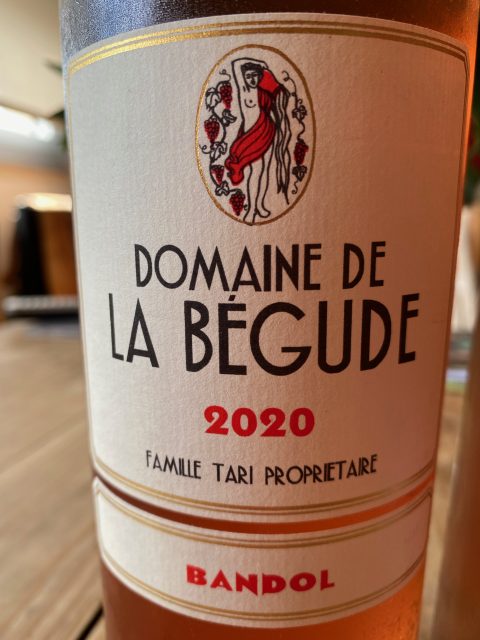 (Bandol; 95% Mourvèdre; 5% Grenache; a tiny amount of Cinsault; a final yield of 24 hl/ha; from a small parcel on an argilo-calcaire terroir; certified organic since 2006; 12.5% alcohol). Gosh. Serious stuff. Closed on the nose, like you don’t really expect with a rosé but what it reveals aromatically is rather beautiful. Almost the parfumier’s essence of tomato consommé were that possible; raspberry flesh; mandarin; grapefruit peel; a hint of redcurrant and cranberry; wild thyme. On the palate, tight and taut and very precise, the fruit tightly strapped to the fresh acidic core. Quite a bit of crumbly calcaire tannin. Serious and seriously long on the finish. In this line-up, quite a star turn (though very undemonstrative). 93. (c. £22* in bond per bottle)
(Bandol; 95% Mourvèdre; 5% Grenache; a tiny amount of Cinsault; a final yield of 24 hl/ha; from a small parcel on an argilo-calcaire terroir; certified organic since 2006; 12.5% alcohol). Gosh. Serious stuff. Closed on the nose, like you don’t really expect with a rosé but what it reveals aromatically is rather beautiful. Almost the parfumier’s essence of tomato consommé were that possible; raspberry flesh; mandarin; grapefruit peel; a hint of redcurrant and cranberry; wild thyme. On the palate, tight and taut and very precise, the fruit tightly strapped to the fresh acidic core. Quite a bit of crumbly calcaire tannin. Serious and seriously long on the finish. In this line-up, quite a star turn (though very undemonstrative). 93. (c. £22* in bond per bottle)
- Château Cibon Cuvée Hommage à Marius 2016* (Côtes-de-Provence, Cru Classé; 90% Tibouren; aged for 18 months in new oak foudres and from a plot of 60 year old vines on the steeply sloping coteau de la Chaine des Maures that plunges down the Mediterranean; 10% Grenache; 14% alcohol). Somewhere between salmon pink, onion skin (really!) and tomato consommé in colour, this is supremely elegant, very distinctive to the point of being divisive, I suspect, and totally unlike any of the other wines here. The oak is beautifully incorporated, bringing a gentle sweet spiciness (cloves and nutmeg) to the racy pink grapefruit freshness and biting acidity and the fascinating combination of almond, walnut, walnut shell, mandarin rind and assorted dried fruits. On the palate this is, again, strikingly fresh but also incredibly intense and concentrated, with a slightly sherried nuttiness once again. Long, sapid and brilliantly refreshing, this is another stunning singularity from Château Cibon, even if it is unlikely to be to every taste. 92+ [*strangely, and endearingly, the cork suggests this is 2016, the label 2018 – I suspect it is the former – either way this is a rare rosé that is genuinely age-worthy]. Chateau Cibon Cuvée Marius 2018 (c. £34 in bond per bottle)
- Clos Cibonne Cuvée Prestige Caroline 2020 (Côtes-de-Provence, Cru Classé; 90% Tibouren; 10% Grenache; from old, largely Tibouren vines perched up on high overlooking the Toulon harbour; 13.5% alcohol; aged for 8 to 10 months in old oak foudres; certified organic and biodynamic). Similar colour to the Cuvée Speciale des Vignettes. Fresher, brighter still and a little less oxidative in style than its sibling, with a lovely combination of quince, mandarin and tamarind alongside the sour cherries, walnut oil and bracken and cut grass/hay. Rich and full and its needs all its acidity not to come across as a little fat – and it just about succeeds, but that is my slight hesitation. Another very distinctive rosé that might provoke something of a marmite reaction – though, actually, I can’t quite make up my mind. I’ll be very interested to re-taste in a year or so’s time. 91+. (c. £16 in bond per bottle)
- Clos Cibonne Cuvée Speciale des Vignettes 2020
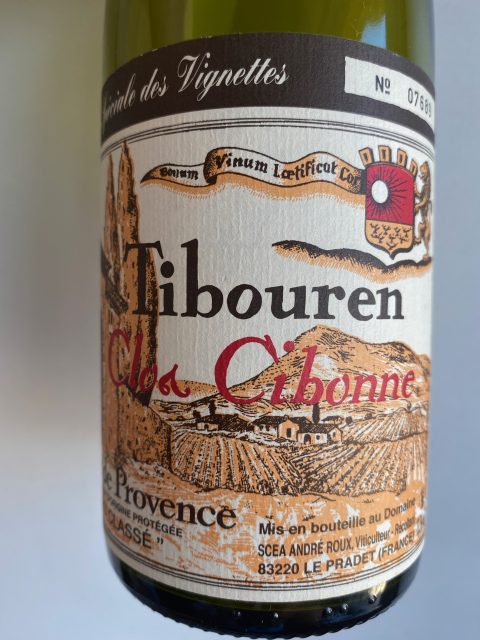 (Côtes-de-Provence, Cru Classé; 90% Tibouren; 10% Grenache; from 50 year old vines; 13.5% alcohol; aged for 12 months in old oak foudres; certified organic and biodynamic). Orange hued, a touch of pink. This is immediately fascinating on the nose – with a slight volatile acidity, a slight suggestion of oxidation and a slight hint of the oak; this has a rich toasty nuttiness to it and also raisins and figs alongside the more classic rosé red cherries. On the palate, strawberries and cream, a touch of sweetness, an almost Fino sherry element and then quince, yuzu, goji berries and pink grapefruit. Quite a heady mix. I like the tannins on the finish. This is one that, tasted blind and at room temperature, could be confused for an aged red. But strangely this also needs time to come together. My note seems paradoxical (lots of things that don’t usually belong in the same paragraph) – but so is this intriguing mystery of a wine. I suspect you’ll love this or you’ll hate it. 91. (c. £26 in bond per bottle)
(Côtes-de-Provence, Cru Classé; 90% Tibouren; 10% Grenache; from 50 year old vines; 13.5% alcohol; aged for 12 months in old oak foudres; certified organic and biodynamic). Orange hued, a touch of pink. This is immediately fascinating on the nose – with a slight volatile acidity, a slight suggestion of oxidation and a slight hint of the oak; this has a rich toasty nuttiness to it and also raisins and figs alongside the more classic rosé red cherries. On the palate, strawberries and cream, a touch of sweetness, an almost Fino sherry element and then quince, yuzu, goji berries and pink grapefruit. Quite a heady mix. I like the tannins on the finish. This is one that, tasted blind and at room temperature, could be confused for an aged red. But strangely this also needs time to come together. My note seems paradoxical (lots of things that don’t usually belong in the same paragraph) – but so is this intriguing mystery of a wine. I suspect you’ll love this or you’ll hate it. 91. (c. £26 in bond per bottle)
- Diane by Jacques Lurton 2021 (Bordeaux rosé; 48% Merlot; 44% Cabernet Sauvignon; 8% Sémillon; 12.5% alcohol). Fleshy pink – the flesh-tone of someone you don’t want to leave out in the sun too long! On the nose, fresh strawberry flesh, peach skin and tomato seeds. Fresh, bright and quite lifted on the entry, with a nice sapidity building along the spine. Simple and a little slender on the finish, but with a nice brightness and a pleasing viscosity in the mouth. 88. (c. £8 in bond per bottle)
- L’Elégance de Clos Cantenac 2021 (Bordeaux rosé; 100% Merlot; high planting density; limestone plateau; fermented in two 7 hectolitre concrete eggs with the lees in constant suspension; tasted at the property during the en primeur tastings and then 3 months later). Very much a challenger to the Cru Classé of the Cotes de Provence. This has a lovely chalky freshness and verticality. Cool summer Merlot. Dense and compact; ultra-fresh; diaphonous. Very gentle at first, with just a hint of chalk tannin bringing additional interest and definition. Serious, substantial and long with a signature grapefruit freshness. Viscous and concentrated through the dense mid-palate. This could almost be a white tasted blind (only the trace of tannin and the slightly viscous salinity really give it away). I love the searing intensity and depth. Wonderfully serious. Very substantial and unlike many of the wines tasted here, this has a tightly and brilliantly defined frame and a lovely sense of structure. Rosé vin de garde. 94. (c. £35 in bond per bottle)
- Chateau d’Esclans Les Clans 2021 (Côtes-de-Provence; Domaines Sacha Lichine; from selected parcels from the 44 hectares of Chateau d’Esclans on a combination of clay, limestone and sandy-gravel terroirs and planted with Grenache, Vermentino and Syrah; vinified and aged in a combination of new and second-use demi-muids; 14% alcohol). Tasted alongside Chateau Minuty 281 and very similar in colour – a crystalline, translucent pink with very slight coppery highlights. Rather different on the nose – more spicy, with cinnamon, ginger and pain d’épice as the first notes that one picks up before the more classic pêches de vignes, white pear and pink grapefruit elements arrive; there’s also a slightly grassy note and a touch of orange blossom and even jasmine. On the palate, this is deep and rich, with a very impressive concentration and density to it. The saline minerality reinforces the impression of viscosity on the palate, providing an architectural spine to the wine in the mouth. I particularly like the lemon rind notes that almost seem to play with and ultimately break up the surface of the wine towards the long finish. The oak is present but very well incorporated and really brings something additional – lending an almost Burgundian complexity to the nose and contributing to the complexity on the palate. A superb wine, that is very distinctive whilst remaining accessible to more traditional lovers of Provençal rosé. 93. *(c. £17.50 in bond per bottle)
- Chateau d’Esclans Garrus 2021 (Côtes-de-Provence; Domaines Sacha Lichine; la tête de cuvée du Château d’Esclans and first made in 2006, this comes from old-vine Grenache now almost a century old; vinified and aged entirely in French demi-muids; 14% alcohol). Alongside Clos du Temple, this is the most iconic rosé produced today in France and probably the world too. The property wants to encourage comparison with the world’s leading white wines and that makes a lot of sense – though it, of course, also shines in this comparative tasting of leading rosé wines. Just a shade more copper and bronze than Les Clans, with the same limpid, crystalline purity – if perhaps just a little more obvious viscosity. There are discernible similarities on the nose too – these are cut from the same cloth – though Garrus is, again, more intense and more concentrated. Raspberry flesh, a hint of red cherry stone, pain d’épices, toasted brioche, grated ginger and a more Burgundian element of straw bales and a gentle nutty natural sweetness that comes from the aging in demi-muids. On the palate this is pure, precise, focussed but also incredibly dense and compact for a rosé with an energetic, almost structural, sense of freshness and a brilliant sapidity on the finish, where the cinnamon notes return again with just a hint of mandarin zest and fresh lime. Very impressive. 94. (c. £80 in bond per bottle)
- L’Exubérance de Clos Cantenac 2021 (Bordeaux rosé; 100% Merlot; 12.5% alcohol; tasted first from a sample an then at the property during the en primeur tastings). Salmon pink/apricot skin. Subtle but bright and vibrant. Wild strawberries, with a hint of cream, verbena and wild thyme, tomato skin and then fresh, bright, citrus notes – lemon curd and confit grapefruit. On the palate, lovely freshness and elegant bright verticality around this viscous core of well-seasoned tomato consommé, with lots of saline minerality. Crisp, almost crystalline and with wonderful, almost structural acidity, giving this a lovely shape in the mouth and sapid, long, tapering finish. I’ve liked each vintage of this – but this perhaps most of all. 91. (c. £10 in bond per bottle)
- Chateau Galoupet 2021 (Côtes-de-Provence; Cru Classé; from an estate of 77 hectares and from 41 parcels vinified separately; 49% Grenache; 15% Syrah; 15% Tibouren; 12% Rolle; 7% Cinsault; and the remaining 2% comprised of Mourvèdre, Cabernet Sauvignon and Sémillon; acquired in 2019 by Moët & Hennessy; 14% alcohol). It’s no surprise that this is good, but it is still something of a surprise just how good it is. Tasted right at the end of the series of wines here and undoubtedly one of the very best; confirmation, were it needed, that French rosé can, at its very best, genuinely warrant cru classé status, figuratively as well as literally (this is, after all, one of the 18 crus classes of the Côtes-de-Provence, and deservedly so on this showing). A very beautiful and rather distinctive orange-pink in the glass with a gloriously appealing and very complex nose of yuzu, bitter almonds and frangipane, white currant, Asiatic pears, pêches de vigne, floral honey and nougat de Montélimar. This is no less radiant on the palate, with a lovely velvety texture and a crystalline, limpid, intensely sapid mid palate. Wow! Extremely long on the iodine-saline finish, impressively dense and concentrated yet lithe, fluid, dynamic and profoundly elegant. About as good as rosé gets. 94.(c. £36 in bond per bottle)
- Galoupet Nomade 2021 (Côtes-de-Provence; 32% Cinsault; 23% Syrah; 22% Grenache; 18% Rolle; 4% Mourvèdre; 1% Tibouren; 13.5% alcohol; this comes in an ultra-light flat slightly cloudy recycled plastic bottle with a screwcap; it certainly doesn’t look like premium rosé but it comes from Moët & Hennessy and Chateau Galoupet and it’s rather good). Somewhere between classic salmon pink and pink grapefruit in colour. Bright and fresh on the nose with more pink grapefruit alongside the red berry fruit and a little hint of pomegranate. On the palate the little hint of sweetness at the start is rapidly overtaken by the fresh, bright acidity – citrus (pink grapefruit zest and pith again being the common element) and a little suggestion of tamarind accentuated the natural salinity. Long and quite rich if a little monotonic. But there’s lots to like here, not least the accentuated acidity and the sense that they’re trying to make a serious rosé in its own right not just an easy crowd-pleaser. I really like the mouthfeel of this, which is silky and lithe despite that wonderful acidity. A brilliant introduction to Chateau Galoupet itself which has me salivating at the prospect of the greater complexity one expects to find with the grand vin – and which is the only thing this lacks. 89. (c. £18 in bond per bottle)
- Domaine de L’Ile 2021
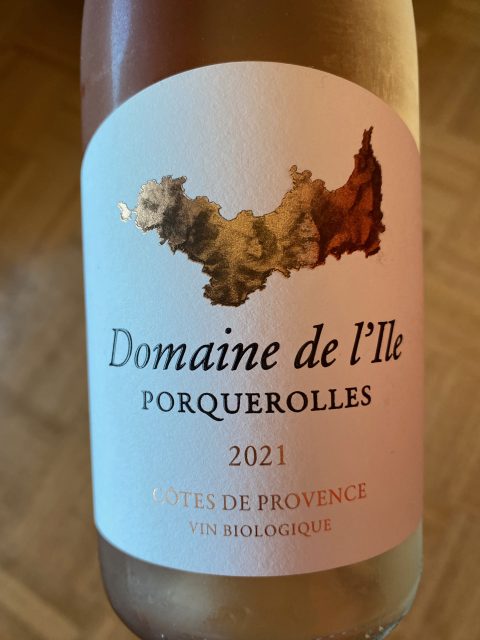 (Côtes-de-Provence; 26% Syrah; 25% Cinsault,;21% Grenache; 6% Tibouren; certified organic since 2015 and purchased by Chanel in 2019; from 32.3 hectares under vine on the Island of Porquerolles, with 70% use for rosé; just 12% alcohol). Light peach skin/pink grapefruit hued with satsuma highlights. Fresh, bright and very citrus-dominated on the nose – with a pleasing fresh spring florality too and notes of blood orange alongside the wild strawberries (without which, tasted blind, this could almost be mistaken for a white). On the palate, this is, again, searingly crisp and fresh with tamarind, quince, mandarin lime zest and white grapefruit pith. Very pure, refined and elegant (more so even than previous vintages I think), this is seriously classy. 91. (c. £15 in bond per bottle)
(Côtes-de-Provence; 26% Syrah; 25% Cinsault,;21% Grenache; 6% Tibouren; certified organic since 2015 and purchased by Chanel in 2019; from 32.3 hectares under vine on the Island of Porquerolles, with 70% use for rosé; just 12% alcohol). Light peach skin/pink grapefruit hued with satsuma highlights. Fresh, bright and very citrus-dominated on the nose – with a pleasing fresh spring florality too and notes of blood orange alongside the wild strawberries (without which, tasted blind, this could almost be mistaken for a white). On the palate, this is, again, searingly crisp and fresh with tamarind, quince, mandarin lime zest and white grapefruit pith. Very pure, refined and elegant (more so even than previous vintages I think), this is seriously classy. 91. (c. £15 in bond per bottle)
- Cuvée Kylie Minogue de Château Sainte Roseline 2021 (Côtes-de-Provence, Cru Classé; selected from the best parcels of the domaine; 40% Grenache; 30% Cinsault; 15% Mourvèdre; 10% Syrah; 5% Tibouren; 13% alcohol). From just 4 tanks and selected by Kylie Minogue herself in partnership with Aurélie Bertin and the team at Château Sainte Roseline. Very classically Provençale in style – strawberries, raspberries, apricots and assorted citrus elements; pleasing hints of mimosa, jasmine and the slightest hint of fresh ginger bringing added interest and additional freshness. Quite rich and full, yet with an impressive sense of lift and energy and a nicely crunchy fresh fruit. The saline minerality on the finish hints at the quality of the argilo-calcaire terroir here. Subtle, gentle, calm and composed if not especially complex, this remains (appropriately enough) very much the crowd-pleaser. 89. (c. £24 in bond per bottle)
Partner Content
- M de Mangot Rosé 2020
 (Bordeaux rosé; 100% Merlot; certified organic and in transition to biodynamic viticulture; 13% alcohol). This is made more like a white wine, with direct pressing of the grapes in stainless-steel tanks at very low temperature and élévage on the lees. Much lighter in colour than the 2020. Pink grapefruit juice. Bright and very fresh and lifted, this is made like a white wine and it has more in common with many whites than roses. Yuzu, assorted citrus notes and tamarind accompany the crunchy cranberry and red cherry fruit. This is very distinctive, with a lovely salty mineral tang and long of zingy citrus acidity. Long and stylish. 91.*(c. £9 in bond per bottle)
(Bordeaux rosé; 100% Merlot; certified organic and in transition to biodynamic viticulture; 13% alcohol). This is made more like a white wine, with direct pressing of the grapes in stainless-steel tanks at very low temperature and élévage on the lees. Much lighter in colour than the 2020. Pink grapefruit juice. Bright and very fresh and lifted, this is made like a white wine and it has more in common with many whites than roses. Yuzu, assorted citrus notes and tamarind accompany the crunchy cranberry and red cherry fruit. This is very distinctive, with a lovely salty mineral tang and long of zingy citrus acidity. Long and stylish. 91.*(c. £9 in bond per bottle)
- M de Mangot Rosé 2021 (Bordeaux rosé; 100% Merlot; certified organic and in transition to biodynamic viticulture; 12.5% alcohol). Significantly darker than the 2020 – peach skin, with almost iridescent pink and orange highlights. Fruitier on the nose too, but with the same signature freshness – red currants, cranberries, goji berries, wild strawberry and almost a little hint of fruits of the forest compote. That lovely saline minerality adds to the sense of viscosity as this glides across the palate where one finds a touch of mandarin, even satsuma and orange blossom. Very well made and a little iconoclastic – just what one would expect from the Todeschinis! 90. (c. £9 in bond per bottle)
- Domaine Maby Prima Donna 2021 (Tavel; 50% Cinsault; 50% Grenache Blanc; the average age of vines is an impressive 52 years; given that fact, an impressive final yield of 45 hl/ha; this comes exclusively from the classic galets roulés (rounded pebble) terroir; around 19,000 bottles; 14.5% alcohol). Impressive. In the class this is dark, with orange, pink and crimson highlight – very much at the interface between pink-tinted and orange-tinted rosé (and rather beautiful in the glass with it). Almost slightly petillant. Crisp, bright, quite vertical in the mouth and with that very ‘Tavel’ tannic presence on the palate that helps give this structure and length. Cucumber skin, tamarind, Seville orange zest and bright plump crunchy red cherries accompany the more classical strawberry notes. Long and quite chiselled on the finish but, as with the Libiamo, I feel the alcohol on the finish and that makes me nudge down my rating a notch. 91. (c. £10 in bond per bottle)
- Domaine Maby Libiamo 2019
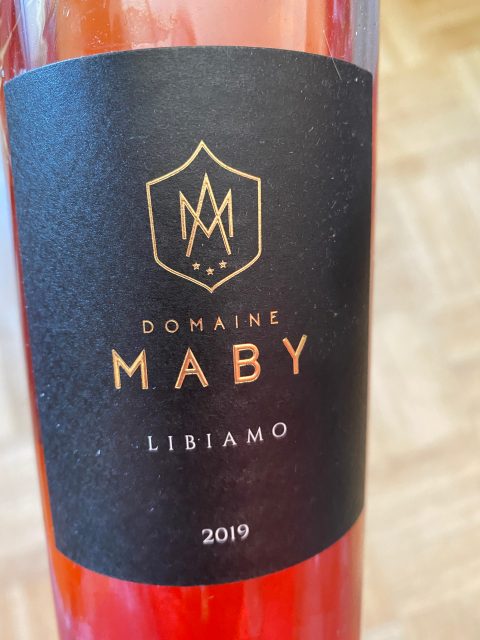 (Tavel; 50% Cinsault; 50% Grenache Blanc; all fermented and aged in new demi-muids; a final yield of 42 hl/ha; only 1300 bottles; 14.5% alcohol). A wine made for aging – ostensibly for up to a decade. Almost more red than orange or pink; with pronounced crimson and blood orange highlights. The oak is subtle but distinctly present on the nose, bringing baking spices (cloves and cinnamon, pain d’epices too) to the red berry and dried fruit notes; there’s a little vanilla too, toasted brioche, frangipane and a mandarin and satsuma zestyness. Long and concentrated, yet always lithe and ultra-fresh on the palate, the oak better integrated here. I like the tannic grip towards the well-defined fantail finish, though I detect just a little the alcohol. An odd, if in a way wonderful, thing to say about a rosé, but it (still) needs time for the oak to integrate. 91+. (c. £16 in bond per bottle)
(Tavel; 50% Cinsault; 50% Grenache Blanc; all fermented and aged in new demi-muids; a final yield of 42 hl/ha; only 1300 bottles; 14.5% alcohol). A wine made for aging – ostensibly for up to a decade. Almost more red than orange or pink; with pronounced crimson and blood orange highlights. The oak is subtle but distinctly present on the nose, bringing baking spices (cloves and cinnamon, pain d’epices too) to the red berry and dried fruit notes; there’s a little vanilla too, toasted brioche, frangipane and a mandarin and satsuma zestyness. Long and concentrated, yet always lithe and ultra-fresh on the palate, the oak better integrated here. I like the tannic grip towards the well-defined fantail finish, though I detect just a little the alcohol. An odd, if in a way wonderful, thing to say about a rosé, but it (still) needs time for the oak to integrate. 91+. (c. £16 in bond per bottle)
- Domaine La Madrague Cuvée Gaspard 2021
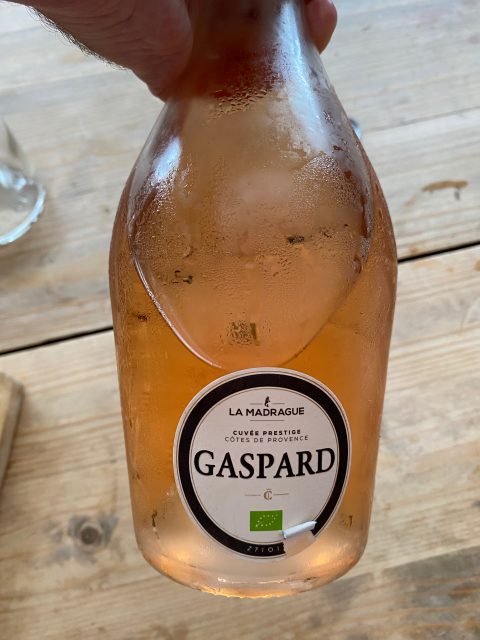 (Côtes-de-Provence; 90% Grenache, 10% Syrah – though strangely the back label says Rolle and Syrah; 13.5% alcohol; certified organic). Unusual in colour. Somewhere between salmon pink and Donald Trump’s tonal pigment (though as this is organic there are no additives here!), with Irn’bru highlights – in short, impressively dark for a Côtes-de-Provence rosé, heralding a certain seriousness (this is darker toned than Pibarnon). Vinous, interesting and classy, with a lovely searing bright freshness on the nose that structures the compact and persistent palate too. Floral, with mimosa, jasmine and a touch of orange blossom. Great viscosity. Complex, even in its youth, with goji berries alongside the red fruits and just a hint of wild sage too. Lots of citrus notes marry nicely with the toasty nutty elements. Very fine and with a lovely purity. 91+. (c. £25 in bond per bottle)
(Côtes-de-Provence; 90% Grenache, 10% Syrah – though strangely the back label says Rolle and Syrah; 13.5% alcohol; certified organic). Unusual in colour. Somewhere between salmon pink and Donald Trump’s tonal pigment (though as this is organic there are no additives here!), with Irn’bru highlights – in short, impressively dark for a Côtes-de-Provence rosé, heralding a certain seriousness (this is darker toned than Pibarnon). Vinous, interesting and classy, with a lovely searing bright freshness on the nose that structures the compact and persistent palate too. Floral, with mimosa, jasmine and a touch of orange blossom. Great viscosity. Complex, even in its youth, with goji berries alongside the red fruits and just a hint of wild sage too. Lots of citrus notes marry nicely with the toasty nutty elements. Very fine and with a lovely purity. 91+. (c. £25 in bond per bottle)
- Château Margüi 2021 (Coteaux-Varois-en-Provence; 45% Grenache noir; 35% Cinsault; 15% Cabernet Sauvignon; 5% Syrah; from a vineyard between 250 and 300 metres on an argilo-calcaire terroir; 13% alcohol). A light salmon pink, with a touch of pink grapefruit flesh. Bright red cherry, wild strawberry (especially on the palate), raspberry, verbena and satsuma. Sapid, juicy and with a signature freshness around which the gentle tannins seem to gather. Fine, with a nice fluid purity if not especially long on the finish or complex. Well-made and accessible. 89. (c. £22 in bond per bottle)
- Château La Mascaronne 2021 (Côtes-de-Provence; a blend of Grenache, Cinsault and Vermentino (Rolle); owned by Michel Reybier of Chateau Cos d’Estournel since 2020, a sixty-hectare vineyard farmed organically since 2016; a strict selection from a single vineyard planted on stone-walled terraces; 13% alcohol). This is the first of Michel Reybier’s Rosés de terroir. Light apricot/salmon pink. This is both fresh and intensely floral on the nose – jasmine, honeysuckle and orange blossom with white peach, nectarine, melon and a little hint of tiny wild strawberries. On the palate this is impressively deep, rich and round, with a lovely bite and pick-up as the fresh acidity announces itself and moulds and structures the fruit and its distribution around the mouth. Dynamic, energetic and quite vibrant, with a pleasing tension between the richness and viscosity on the one hand and the fresh acidity on the other. There is just enough of the latter; and, in the end, it has the upper hand. For this is well-sustained by the citrus elements on the long, sapid and refreshing finish. 92. (c. £8 in bond per bottle)
- Chateau Minuty 281 2021 (Côtes-de-Provence, Cru Classé; a blend of Granache, very much in the ascendancy, and a little Syrah grown on a combination of schist, clay and sandy terroirs; 12.5% alcohol). A beautiful luminous , crystalline and translucent subtle pink, with just a hint of orange. Beautifully refined and very lifted on the nose, with plump fresh raspberry plucked from the husk, shading towards mandarin, orange zest and lemon rind notes. Pure and crystalline again on the palate, with a lovely vibrancy and sense of energy; very fluid, lithe and charged with energy. Precise, focussed and very elegant. Exuding class. I love the rocky, slightly saline minerality and the return to raspberry on the finish. 93. (c. £33 in bond per bottle)
- Domaine de la Mordorée ‘La Dame Rousse’ 2021 (Tavel; 60% Grenache; 10% Cinsault; 10% Syrah; 10% Mourvèdre; 5% Clairette; 5% Bourbourenc; 14.5% alcohol; biodynamically certified). The highest level of alcohol of any of these and definitely amongst the very darkest in the glass – pomegranate and red cherry juice, with crimson and pink highlights. Aromatically very distinctive, with dried flowers, rose petals, garrigue herbs and a dusty, earthy minerality alongside the pink gooseberry flesh, red cherry, pomegranate and fresh plum skin notes. Very fresh and impressively concentrated on the palate, with a tight, compact dense core built around the pink grapefruit pith spine. The florality reappears on the finish, with a little fleur d’oranger too. Excellent value. 91. *(c. £10 in bond per bottle)
- Domaine de la Mordorée ‘La Reine des Bois’ 2021
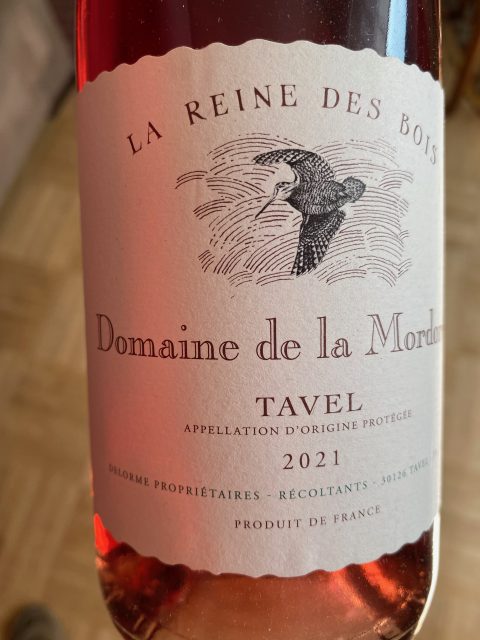 (Tavel; 60% Grenache; 15% Clairette; 10% Syrah; 10 % Cinsault; 5% Bourboulenc; 14.5% alcohol; biodynamically certified; from a single parcel planted on classic galet terroir). A lovely, limpid pomegranate pink with ruby highlights – the colour of grenadine in fact. More serious, more vinous and more ‘red’ on the nose – with almost a hint of Loire Pinot about it! Intensely floral, with those old-fashioned aromatic pink-tinged yellow roses, pomegranate and red cherry stones, but also the fruit cocktail confectionary of my childhood – and a hint of fresh basil. On the palate, this is soft and gentle on the attack with a bright, fresh pick-up as the citrus components engage and vivify the darker red berry fruit notes lifting the wine to the top of the palate as they do so. Energetic, engaging and one of those very composed and natural wines that almost tastes biodynamic. Paints a lovely linear trace along the top of the palate on the finish. 92+ *(c. £17 in bond per bottle)
(Tavel; 60% Grenache; 15% Clairette; 10% Syrah; 10 % Cinsault; 5% Bourboulenc; 14.5% alcohol; biodynamically certified; from a single parcel planted on classic galet terroir). A lovely, limpid pomegranate pink with ruby highlights – the colour of grenadine in fact. More serious, more vinous and more ‘red’ on the nose – with almost a hint of Loire Pinot about it! Intensely floral, with those old-fashioned aromatic pink-tinged yellow roses, pomegranate and red cherry stones, but also the fruit cocktail confectionary of my childhood – and a hint of fresh basil. On the palate, this is soft and gentle on the attack with a bright, fresh pick-up as the citrus components engage and vivify the darker red berry fruit notes lifting the wine to the top of the palate as they do so. Energetic, engaging and one of those very composed and natural wines that almost tastes biodynamic. Paints a lovely linear trace along the top of the palate on the finish. 92+ *(c. £17 in bond per bottle)
- O de Rose Cuvée Prestige 2021 (AOP Languedoc; from Maison Lorgeril; 50% Grenache; 30% Syrah; 10% Cinsault, 10% Rolle [Vermentino]; 13% alcohol; from relatively high altitude parcels on argilo-calcaire terroirs). Predominantly rose pink with a touch of salmon flesh. This reminds me of fruit salad flavour sweets on the nose and, as that suggests, it’s a little sweet-scented. But there is also a pleasing vertical fresh lift and nice hints of grapefruit alongside the red cherry skin, strawberry and raspberry compote notes. On the palate, this is lithe, cool, calm and composed with the bright acidity nicely distributed over the palate. A little hint of mandarin on the sapid finish. But just a little bit dull. Promoted as a rosé de gastronomie, I was hoping for something a little more distinctive. This seems to play to the gallery just a little too much. 87. (c. £6in bond per bottle)
- Domaines Ott Chateau Romassan 2021 (Bandol; 55% Mourvèdre; 30% Cinsault; 14% Grenache; 1% Syrah, assembled from the best parcels of the this 76 hectare estate planted on a limestone, sandstone and sandy marl terroir; 13% alcohol; part of Maison Louis Roederer). A light salmon pink, this is appealingly bright and fresh on the nose, with white flowers and that tell-tale tomato consommé note alongside delicate stone fruits – apricots, peche de vigne, red cherries and a pronounced and complex citrus component – grapefruit, lime and a hint of mandarin. Sapid and crystalline on the palate but with impressive depth and concentration (though always presented in a subtle and elegant way), this is stylish, sleek, very precise and long on the finish. One of the best on show. 92. *(c. £16 in bond per bottle)
- Domaines Ott Clos Mireille 2021 (Côtes-de-Provence, Cru Classé; 70% Grenache; 25% Cinsault; 5% Syrah; from a vineyard with an average age of 16 years on a schist and clay terroir overlooking the Mediterranean at La Londe Les Maures; 13% alcohol; part of Maison Louis Roederer). Presented in a beautifully designed bottle that dates from the 1930s, this is very pale with palid pink and orange highlights, but what intensity on the nose. The finest muslin-dripped tomato consommé, almond skins, laurel and pink grapefruit, with a little redcurrant and cranberry. Brilliantly bright, vibrantly fresh and very vertical in presentation, this is viscous on the palate and impressively concentrated. It’s also incredibly long. Fabulous. 93. (c. £19 in bond per bottle)

- Chateau Pibarnon Rose 2021 (Bandol; 65% Mourvédre, 35% Cinsault; 13.5% alcohol; certified organic). A classic expression of an iconic wine. Pink grapefruit and salmon fresh coloured, with almost iridescent orange highlights accentuated by the summer sunshine. Serious rosé. Tomato consommé, a hint of redcurrant and cranberry, pink gooseberry, a touch of orange blossom and a scratch or two of lime zest. On the palate this is dense and compact, viscous and tightly bound to the zesty citrus core. Fraise de bois and a touch of quince, almost tamarind. Seriously fresh and very long on the finish, though in need of a little more bottle age for its true complexity to be revealed; I love the little tannic grip towards the finish. 91. (c. £20 in bond per bottle)
- Le Rêve (Côtes-de-Provence; from Jonathan Maltus; a limited edition of 6000 bottles and 600 magnums; a blend of Grenache and Syrah grown on a clay-limestone terroir in Flassans-sur-Issole; 13% alcohol). Crystal clear salmon-pink with pink grapefruit highlights. Bright, crisp and quite lifted on the nose with tomato consommé, grapefruit and wild strawberry notes. On the palate, this is juicy, fresh and with lots of forward drive across the palate and a good intensity; the citrus notes are prominent alongside the crushed raspberry and strawberry fruit, with just a hint of residual sugar and a lovely verbena note on the finish. 89. (c. £24 in bond per bottle)
- Chateau Sainte Roseline Cuvée La Chapelle de Sainte Roseline 2021 (Côtes-de-Provence, Cru Classé; 90% Mourvèdre; 5% Rolle; 5% Grenache; from a selection of the very best parcels on argilo-calcaire terroirs; 13% alcohol). A beautiful light salmon pink and a lovely, slightly delicate, wild strawberry, cherry (almost cherry flavoured cough drops) and frangipane, lychée and passionflower nose. Taut and fresh, with lots of forward momentum on the palate, this very much defined by the bright, crystalline purity of the wild strawberry element. There’s a little bite and grip from the tannins, reinforcing the pink grapefruit fresh acidity on the finish quite beautifully. Very nicely poised, classy and composed. Quite serious without ever risking becoming intimidating. Definitely one of the picks of the tasting. 92+. * (c. £18 in bond per bottle)
- Domaine Tempier
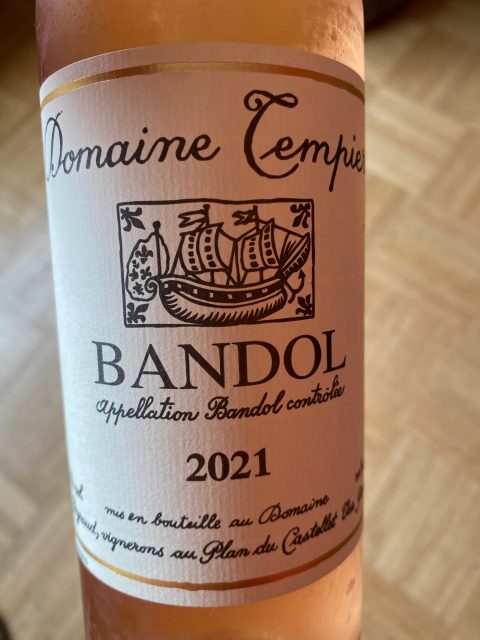 (Bandol; 50% Mourvèdre; 28% Grenache; 20% Cinsault; 2% Carignan; from a variety of terroirs depending on the varietal, but essentially all on argilo-calcaire soils; alcohol 13%). One of the lightest hued, certainly of the Bandol wines – peach juice and cantaloupe melon, a hint of tangerine. Fabulously bright, vertical and intensely crisp and crunchy, with lovely almost white varietal citrus elements, assorted fresh spring flowers, quince, green apple skin and confit melon. Shimmering and very pure and crystalline on the palate with lovely concentration and a very well-defined linear vein that guides the fruit towards its distant vanishing point on the long finish. A lovely sense of structure and harmony and one of the undoubted stars of this tasting from an iconic estate. Excellent. 92. (c. £23 in bond per bottle)
(Bandol; 50% Mourvèdre; 28% Grenache; 20% Cinsault; 2% Carignan; from a variety of terroirs depending on the varietal, but essentially all on argilo-calcaire soils; alcohol 13%). One of the lightest hued, certainly of the Bandol wines – peach juice and cantaloupe melon, a hint of tangerine. Fabulously bright, vertical and intensely crisp and crunchy, with lovely almost white varietal citrus elements, assorted fresh spring flowers, quince, green apple skin and confit melon. Shimmering and very pure and crystalline on the palate with lovely concentration and a very well-defined linear vein that guides the fruit towards its distant vanishing point on the long finish. A lovely sense of structure and harmony and one of the undoubted stars of this tasting from an iconic estate. Excellent. 92. (c. £23 in bond per bottle)
- Clos du Temple 2018 (Languedoc Cabrières; made from Syrah, Grenache, Cinsault, Viognier and Mourvèdre; certified organic and biodynamic; the first vintage of this ultra-premium limited production rosé from Gérard Bertrand which comes in custom-designed bottles; 14.5% alcohol). Remarkably, given the additional three years it’s already had in bottle, this is practically identical visually to the 2021 – with perhaps just a hint more of gold leaf on swirling. But this is a strikingly different wine on the nose and palate. It’s immediately sweeter and richer on the palate – slightly oakier too and with an almost Jurançon sec slightly oxidative, style to it – with raisins, sultanas and currants, figs and walnuts, and even a hint of pineapple joining the fresh, plump raspberry fruit. But what I like the most are the citrus and spice notes, especially in their combination. We have yuzu, grapefruit zest and a cornucopia of warm Asiatic and Caribbean spices. On the palate, this is, again, impressively dense and compact, yet layered and with a very evident structure and evolution over the palate. It’s perhaps unfair to compare this with the other, younger, wines of the tasting – but, quite frankly, this is one of the very few wines here that would benefit (and, as here, has benefitted) from its bottle aging. A singular and unique wine with all the attributes of a grand cru – though I suspect the 2021 will be even more impressive in 3-5 years’ time. You’d be doing very well if you could pick the varietals present here tasting this blind (and blind-folded). 93. (c. £148 in bond per bottle)
- Clos du Temple 2021 (Languedoc Cabrières; made from Syrah, Grenache, Cinsault, Viognier and Mourvèdre; certified organic and biodynamic; aged in new French oak; 14% alcohol). Fascinating. The most expensive wine in the tasting by some distance, and definitely one of the strongest showings. This is perhaps the single wine in the tasting most easily (mis)taken for a white when tasted blind. It’s also very pale in the glass, with the mildest shades of pink and orange – freshly squeezed pink grapefruit juice perhaps, with a little copper and even golden highlights on swirling. Subtly spicy, with nutmeg, grated ginger and cinnamon bark accompanying the white flowers, yuzu, lime, Asiatic pear and white nectarine; a little hint of loganberry too; with air, a lovely coconut note appears too, and the slightest suggestion of truffle. This is dynamic and very complex. Continuing in the same vein, on the palate this is both intensely energetic and lively but also deep, rich and concentrated, with a very linear spine of citrus freshness around which the complex palate assembles and builds. Long and with a lovely sapid tapering finish, there is surprisingly little trace of the oak. Lovely harmony and balance. A rosé apart. 95. (c. £140 in bond per bottle)
To read more about Grand Cru rosé, click here.
Related news
Castel Group leadership coup escalates
For the twelfth day of Christmas...
Zuccardi Valle de Uco: textured, unique and revolutionary wines



